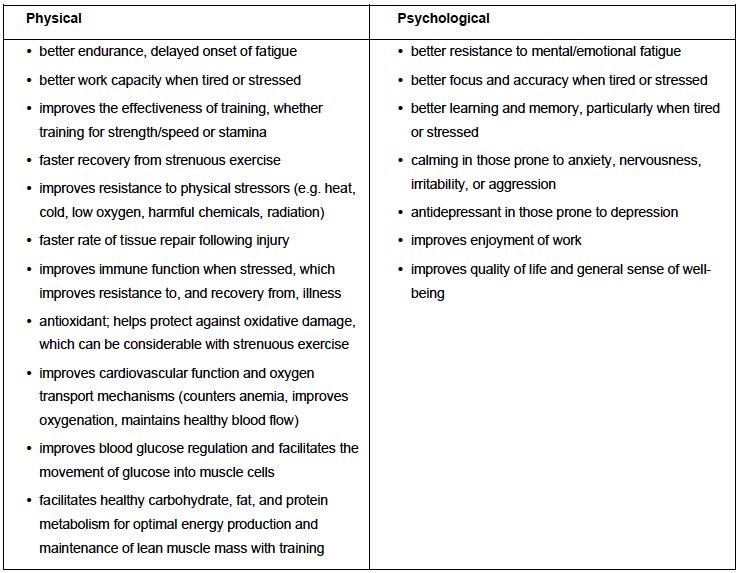
Christine King BVSc, MANZCVS (equine), MVetClinStud
Adaptogens and the working dog
on performance, injury, and career longevity
This article is the first of two on adaptogenic herbs in dogs. The second is on senior dogs.
I love dogs. I especially love working dogs, for the enthusiasm they bring to their work, for their generous spirits, and for the pride they take in doing a good job. So, I love working with working dogs and helping them cope better with the inevitable stresses of their jobs.
Stress and limits
Stress is an inescapable part of being alive. But while the word “stress” has an almost universally negative connotation in our culture, stress is not always a bad thing. In fact, our bodies need a certain amount of repeated stimulation in order to maintain our capacity to respond to whatever life brings, and to increase our capacity for work and our resistance to injury and illness.
The trouble comes when we are repeatedly operating at or near our limits, whether physically or psychologically, and often both. As long as we remain below our current limits, then damage is minimal and adaptation is possible, even inevitable with the right input. However, when we are operating in the 90+ percent range of our capacity, as many working dogs are, it is very easy to step over that invisible line and exceed our capacity. Injury or illness occurs, either a little at a time or in one catastrophic failure, when the structural or functional limits of the body are exceeded. The same could be said of the mind and its mental and emotional limits. There is some elasticity; but when overstretched, the elastic breaks.
Physically, and probably psychologically as well, training is most effective when we are operating in our 90+ percent range, but below 100 percent (the point beyond which damage can occur). The common notion that it is good to “give 110 percent” (or 150 percent or 1000 percent or some other mathematical absurdity) needs to be dropped from our thinking. Giving 110 percent means you’re putting yourself in debt to the tune of 10 percent each time. That is not a good thing; it is neither honorable nor smart, as the resulting damage tends to be cumulative.
Along the same lines, “no pain, no gain” also needs to go the way of the Dodo. It is simply untrue, and a harmful fallacy at that. An athlete does not gain in work capacity (strength/speed or stamina) because he exceeded his limits and made himself hurt; he gained in capacity despite it — and prolonged his recovery time in the process. Not smart!
The trick, of course, is to know where the limit is before one exceeds it, and to train effectively at a level just below maximum, which changes as training advances. That is difficult for a human athlete. It is even more difficult when training a body other than your own, especially an animal. It takes great care to develop a dog’s physical and psychological capacity while avoiding breakdown and burnout.
“Good” stress vs. “bad” stress
One researcher proposed two different categories for the various stresses we experience:
- eustress for stress that is simply challenging and ultimately stimulating to the system (eu- being the Greek word element meaning “normal,” “good,” “well,” or “easy”)
- distress for stress that is of sufficient intensity or duration that it overwhelms and ultimately damages the system
Although these terms haven’t really caught on, that simple distinction is important. We don’t want to do away with stress altogether. Our capacity is not maintained without some regular stimulation (the basis of “use it or lose it”); and our capacity is not increased without some extra stimulation. We simply want to better manage the various stresses of life and work, and better manage our responses to them. That’s where adaptogens can be very helpful to the working dog: by shifting the line between eustress and distress over to the right, so less of what is encountered distresses the system and causes damage.
I’ll mostly be talking about canine athletes here, but the same principles apply to working farm dogs, search-and-rescue dogs, other types of service dogs, and in fact any dog with a physically or psychologically demanding job. The service dogs rate a particular mention here because their exposure to stress may not be as obvious as for the athletes. Whether a dog is working security or helping someone in a wheelchair, the mental and emotional demands of these jobs can be considerable, as can the hours, and research has shown that psychological stress has the same effects on the body as physical stress. Fortunately, the adaptogens can be a great help here, too.
What’s an adaptogen?
Adaptogen is the term used for a substance that helps the body adapt to various stresses, both physical and psychological. A “state of nonspecific resistance” is one of the concepts often discussed in reference to adaptogens. For the most part, “adaptogen” is used to describe a particular group of herbs that confer these qualities on a body. With the help of these herbs, the body is more resistant to whatever comes at it that might cause it harm.
Some of these herbs you’ll have heard of already, such as Siberian ginseng (or 'eleuthero') and the various Asian and American ginsengs. Others include rhodiola, schizandra, aralia, and rhaponticum. These are the most studied adaptogens, but there are several others (see Table 1 at the bottom of this page).
One thing most of the adaptogenic herbs have in common is that the plants are indigenous to rather inhospitable or very changeable climates (e.g., Siberia, Manchuria, the Himalayas). There’s a clue to their usefulness in helping us cope with “inhospitable” circumstances. The various substances we find of nutritional or medicinal benefit in a plant are, for the most part, designed for the plant’s own use. In this instance, we’re using a part of the plant’s coping strategy for dealing with its own stresses (i.e., various bioactive molecules in its roots, stems, fruit, etc.) to help us cope better with our stresses. There is a remarkable degree of overlap between plant and animal systems in the actions of various biochemicals. With many, including adaptogenic herbs/substances, the translation is simple and direct. We are able to make good use of their “stress management” substances to help our own systems cope in the short-term and adapt in the long-term.
Table 2 lists some of the properties that are shared by most, if not all, of the adaptogens, and Table 3 lists some other properties that are more-or-less unique to the individual herbs. Although the adaptogens each have their own “signature” properties, a feature they all share is the ability to help normalize the various functions of a disordered system. Regardless of the type and direction of disorder (whether under- or over-activity), the adaptogens help the body return to a state of equilibrium, to the normal functions and responses of a healthy system. In other words, they help restore the body’s ability to autoregulate.
By the way, that is where much of the skepticism about these herbs arises, as the list of specific actions, and thus potential medicinal benefits, for any of these herbs is long. I’ll have more to say about that in a separate article on adaptogens and the senior dog. There’s lots to talk about with respect to beneficial effects on the immune system, the cardiovascular system, the digestive system, the central nervous system, and the endocrine system. Of course, all of these systems are involved in exercise or in keeping the athlete healthy, but in this article I want to focus on the issues of primary concern in the working dog: performance, injury, and career longevity.
As Table 3 shows, some of the adaptogens have primary properties that are of particular value to us for specific situations (e.g., schizandra for alertness or better vision in poor light; rhaponticum for its anabolic properties), but the adaptogens all facilitate a return to normal function. And most, if not all, of these herbs also improve endurance, work capacity under stress, and recovery after strenuous activity, all of which are helpful for the working dog.
The research on these herbs is extensive and intricate, but most of the studies have involved humans and lab animals, so we’ve had to extrapolate for horses, dogs, and other domestic animals. Even so, adaptogens are among the most studied medicinal herbs. Both their safety and the various therapeutic and performance-enhancing claims have been put to the test using rigorous scientific methods. Furthermore, these herbs have a long and proven track record in human athletes and workers (a good deal of the research was done on people in stressful jobs), so let’s take a look at where adaptogens might be of use to the working dog.
Benefits for working dogs
The various properties and potential of the adaptogens for the working dog can be summarized as follows:
- better performance, both now and over time
- greater enjoyment of work and play
- fewer injuries and illnesses, and faster recovery from injury or illness
- longer career (i.e., later retirement)
In other words, a healthier, happier working dog. Let me emphasize, though, that there is no substitute for good training and considerate care. Adaptogens are not a shortcut to better performance, and unlike stimulants and anabolic steroids, they will not enhance a dog’s performance beyond his or her natural ability. All the adaptogens can do with respect to performance is help the dog do his or her natural best under the conditions of stress inherent to the job and its associated circumstances (e.g., traveling, working and sleeping in unfamiliar surroundings, excessive heat or cold, loud noises, poor air quality).
It must also be said that the findings pertaining to exercise capacity in humans and lab animals have been conflicting, with some studies showing significant performance benefits and others showing no effect. Performance benefits are most consistently seen in untrained or inadequately prepared individuals and in older people/animals (e.g., human athletes over 40). When benefits are seen in fit, young, well-prepared athletes, it has typically been when the athlete is tired. That’s because the adaptogens can delay the onset of fatigue, allowing the athlete to perform for longer before tiring.
In fact, that’s one of the primary ways adaptogens can decrease the risk for injury. Most sports injuries occur when the athlete is tired; specifically, when muscle fatigue sets in. When we begin to tire, our foot placement and balance begin to deteriorate, as does our concentration, so we’re more likely to take a misstep that can cause tissue damage. The adaptogens further help here by improving mental (and with some, visual) acuity, so the athlete is more focused and can concentrate better on the task, even when tired. Here again, the adaptogens appear to be of limited benefit when the athlete is well rested and on the ball; they are of greatest benefit when the athlete is tired or otherwise stressed.
Another way adaptogens help with injury prevention and recovery is by stimulating the synthesis, metabolism, and repair of proteins within cells. Adaptogens switch on various cell functions which help maintain a healthy lean muscle mass and quickly repair cells and tissues when damage occurs. Athletes performing in strenuous sports are training and competing close to their body’s limits, frequently stepping over that invisible line for a short time. Microtrauma (microscopic tissue damage) is common and cumulative in these athletes. By improving the rate of protein synthesis and tissue repair, adaptogens can reduce the potential for microtrauma to escalate into an injury which sidelines the athlete for weeks or months, or for life.
This, too, is how adaptogens can extend a working dog’s career. Whether retirement is forced by injury, illness, loss of performance, or loss of enjoyment, the proper use of adaptogens — together with a healthy diet, a good training program, and all of the other bits & pieces that go into keeping a working dog healthy and happy — can postpone the day when retirement becomes necessary.
Which adaptogens are best?
Many different plants contain bioactive substances that could be considered to have adaptogenic potential in an animal. These substances are part of the plant’s stress management system, and every plant has some sort of defend/repair/adapt system. It just so happens that some of these plant substances can benefit the animal’s stress management system as well. For working dogs, coping with a wide range of physical and psychological stressors, a combination of adaptogens makes sense to me. I do sometimes use adaptogenic herbs singly, but typically I combine two or more for a broader range of benefit. While the core actions are common to almost all adaptogens, some herbs are more helpful than others for particular situations (see Table 3).
Most of these herbs can be found singly or in various combinations in human health food stores, natural grocery stores, and some fitness centers. My preference, though, is to use a product that has been specifically prepared for animal use: in species-appropriate formulations and concentrations, with species-specific dosing instructions, and with veterinary input. There are now a number of good adaptogenic products on the market for animals. One of my favorites is APF Pro by Auburn Labs (auburnlabs.com). APF was originally formulated by an equine veterinarian for use in horses. It was intended primarily for equine athletes, but as time went on we veterinarians also found it helpful in the management of various medical conditions. The company now has a canine version of APF Pro labeled specifically for dogs.
I particularly like that APF is a liquid and is easy to dose (the dropper is well marked). I also appreciate that this company is committed to quality control and to veterinary research. I’m guessing that they’ll be among the first to publish studies on adaptogens in pet and performance dogs. Until that time, the studies in human athletes and people in stressful jobs give us a good foundation for using these herbs in working dogs.
How much, how often, and for how long?
How much depends on the product you’re using. I’d suggest that, unless you’re very familiar with these herbs, you follow the label directions or your veterinarian’s advice. If buying these herbs as products formulated and labeled for humans, it’s usually OK to scale down the dosage for dogs according to body weight. Most human supplements that do not give separate dosages for men and women are formulated on the premise that the “typical” human weighs 150 lbs. So, if giving that product to a 50-lb dog, for example, you’d aim for about 1/3 the recommended label dosage, unless your veterinarian directs you otherwise. Fortunately, all of the adaptogens studied thus far have nice, wide safety margins, so if you accidentally give that 50-lb dog an entire human-size dose, the dog is unlikely to come to any harm.
As for how often, I usually recommend giving the product once a day, in food, although when dealing with serious illness or stress I’ll often recommend being extra generous with the dosage and giving it twice a day. In some of the research using mice or rats, the herb was effective even when it was dosed in the animals’ drinking water. None of these herbs taste great, so I was encouraged to learn that doctoring the drinking water is a palatable option. I have yet to try that with my patients, but I do sometimes take APF myself in a cup of tea and manage to get it down alright. (It really isn’t all that bad.)
As for how long, another cool thing about the adaptogens is that an effect may be seen with just one dose, particularly with rhodiola and schizandra. That’s been well documented in both human and animal studies. One might argue that there was a placebo effect at play in the human studies. Possibly; but in the better studies, the design of the study accounted for that, and still there was a genuine, positive effect after just one dose. The placebo effect was not present in the animal studies, as the outcomes tested were all measurable things (e.g., time taken to complete a novel maze). So, taking adaptogens only occasionally, such as right before or even during a physically or psychologically demanding event, can still be of benefit.
Of course, true adaptation — greater general resistance to stress, rather than simply coping better with a current stress — takes longer and takes repeated dosing, in the order of 2–4 weeks. Beyond that point I find that I can often lower the dosage for maintenance in a healthy athlete, and go up and down in dosage according to the level of stress. For example, we might end up with a “home” dosage that is about half of the “travel” or “show” dosage. That seems to result in the best balance of economy and efficacy in my practice.
Well, that’s about it for now. I hope I’ve inspired you to start playing with this wonderful group of herbs in your working dog. Next up, adaptogens and the senior dog.
***
Sources
The scientific papers referenced in this article are listed at the end of the second article (Adaptogens and the senior dog).
*****
Copyright © 2010 Christine M. King. All rights reserved.
Table 1. Some of the better known adaptogenic herbs

* Siberian ginseng is not a true ginseng (i.e., a plant from the Panax genus),
but it shares several properties with the “true” ginsengs, hence its common name.
Several of the medicinal mushrooms also have some adaptogenic properties.
They include cordyceps, reishi, maitake, and shiitake.
Table 2. Properties common to most adaptogens that may be especially useful for the working dog.

Table 3. Some specific properties of five adaptogens.
(These herbs have many more documented properties; below are just those of particular relevance in working dogs.)
